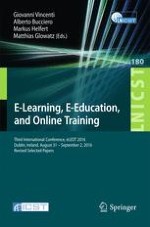2017 | Book
E-Learning, E-Education, and Online Training
Third International Conference, eLEOT 2016, Dublin, Ireland, August 31 – September 2, 2016, Revised Selected Papers
Editors: Giovanni Vincenti, Alberto Bucciero, Markus Helfert, Matthias Glowatz
Publisher: Springer International Publishing
Book Series : Lecture Notes of the Institute for Computer Sciences, Social Informatics and Telecommunications Engineering
